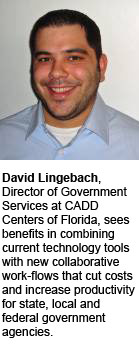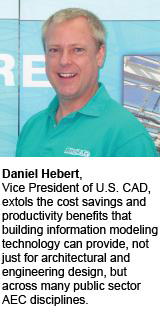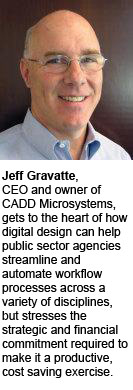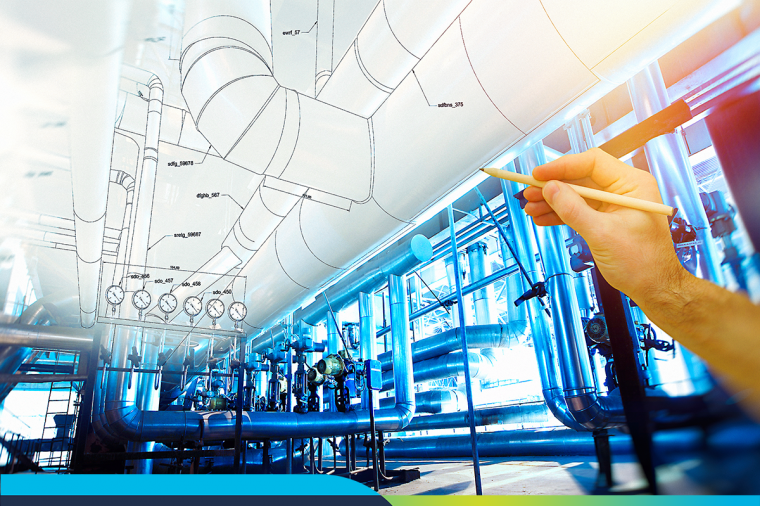Using Technology to Deliver Better Constituent Services on a Tighter Budget
Got questions? We’ve got answers. Each issue our team of experts weighs in on a variety of topical issues relevant to public sector digital design. In this issue our team of experts includes leading technical and public sector experts from Avatech Solutions, CADD Centers of Florida, U.S. CAD, and CADD Microsystems.
With the weight of current economic pressures on business organizations and government agencies alike, we asked our network of experts to weigh in on the following question:
As the ebb and flow of the U.S. economy takes us from times of prosperity back to times of cutbacks, state, local and federal government agencies must do more with less. At the same time, government faces pressure to deliver better services. What role can digital design technologies play now and in the future to help agencies balance these conflicting demands?
 Answer: “Like many local governments across the country, cities and counties in Florida have been hit particularly hard by the recent economic downturn. Combine this with the state-wide property tax cuts that all but crippled the budgets of smaller municipal governments, it is more important than ever to find ways in which technology can help us “do more with less.”
With CAD technology playing a much greater role across a wide variety of government services, we are seeing a certain urgency within state and local government to re-evaluate older work flows and processes in ways that maximize the investment in, and use of, digital design technology. If anything, the current economic climate provides a definite imperative for new ideas and innovation which help cut costs, reduce waste and maximize productivity.
One of the greatest challenges many local governments are facing is an ever-increasing backlog of GIS work. GIS departments are responsible not only for editing and updating data like utility maps, road maps and parcel maps, they are also responsible for responding to multiple departments requesting accurate GIS information for city functions like property assessments, capital improvement projects and utility distribution.
By utilizing more advanced CAD technology like AutoCAD® Map 3D, GIS departments gain greater interoperability with CAD and GIS data, reducing the need to recreate data multiple times. AutoCAD Map 3D also allows for multi-user editing, making it easy for design teams and GIS professionals to update multiple map layers at the same time and increase team productivity. In addition, many GIS departments have begun publishing GIS data to the Internet or internal intranets using Autodesk’s MapGuide Enterprise and MapGuide Studio software. By providing this data in an online format, it is easier to share data with other city departments and reduce the backlog of requests.
Community development is a large part of what local government does, and often at very large expense. Building renovation, new construction and capital improvement projects are just a few of the areas in which public works and building and planning departments can cut costs with better use of digital design technology.
Mandating the use of building information modeling (BIM) for in-house design work and plans submitted by general contractors and Design/Build firms is an excellent (and inexpensive) way to reduce the wasted time and money RFIs and construction errors produce. BIM models can also help facility managers operate and maintain government buildings more efficiently. Requiring LEED standards for new building projects can help reduce increasingly higher energy costs.
Federal government agencies like the General Services Administration and the Department of Veterans Affairs are leading the way in setting LEED standards for government building in an effort to reduce federal building energy consumption by more than 30 percent. Many well-established design firms have already long been using purpose built solutions for BIM like Revit Architecture, and government agencies should follow suit to gain the full benefit of what BIM and LEED standards can do to reduce waste and cut costs.”
Answer: “Like many local governments across the country, cities and counties in Florida have been hit particularly hard by the recent economic downturn. Combine this with the state-wide property tax cuts that all but crippled the budgets of smaller municipal governments, it is more important than ever to find ways in which technology can help us “do more with less.”
With CAD technology playing a much greater role across a wide variety of government services, we are seeing a certain urgency within state and local government to re-evaluate older work flows and processes in ways that maximize the investment in, and use of, digital design technology. If anything, the current economic climate provides a definite imperative for new ideas and innovation which help cut costs, reduce waste and maximize productivity.
One of the greatest challenges many local governments are facing is an ever-increasing backlog of GIS work. GIS departments are responsible not only for editing and updating data like utility maps, road maps and parcel maps, they are also responsible for responding to multiple departments requesting accurate GIS information for city functions like property assessments, capital improvement projects and utility distribution.
By utilizing more advanced CAD technology like AutoCAD® Map 3D, GIS departments gain greater interoperability with CAD and GIS data, reducing the need to recreate data multiple times. AutoCAD Map 3D also allows for multi-user editing, making it easy for design teams and GIS professionals to update multiple map layers at the same time and increase team productivity. In addition, many GIS departments have begun publishing GIS data to the Internet or internal intranets using Autodesk’s MapGuide Enterprise and MapGuide Studio software. By providing this data in an online format, it is easier to share data with other city departments and reduce the backlog of requests.
Community development is a large part of what local government does, and often at very large expense. Building renovation, new construction and capital improvement projects are just a few of the areas in which public works and building and planning departments can cut costs with better use of digital design technology.
Mandating the use of building information modeling (BIM) for in-house design work and plans submitted by general contractors and Design/Build firms is an excellent (and inexpensive) way to reduce the wasted time and money RFIs and construction errors produce. BIM models can also help facility managers operate and maintain government buildings more efficiently. Requiring LEED standards for new building projects can help reduce increasingly higher energy costs.
Federal government agencies like the General Services Administration and the Department of Veterans Affairs are leading the way in setting LEED standards for government building in an effort to reduce federal building energy consumption by more than 30 percent. Many well-established design firms have already long been using purpose built solutions for BIM like Revit Architecture, and government agencies should follow suit to gain the full benefit of what BIM and LEED standards can do to reduce waste and cut costs.”
 Answer: “The revolution around building information modeling (BIM) is the best way for state, local and federal government agencies to do more with less while delivering better services. These two seemingly conflicting demands are exactly why commercial companies are so quickly making the move to BIM and Revit® in particular, Autodesk’s purpose-built BIM software.
One of the challenges of traditional CAD is the constant repetition of data. In a typical set of construction documents, you have the same information showing in plan, section, elevation and schedules. With traditional CAD tools, the information in each of these views must be drawn separately each time and, as design changes are made to the documents, these edits must also be made separately in each view. This not only takes time, but also results in poorly coordinated documents that are highly prone to error.
BIM largely solves this issue by allowing you to focus on creating a single digital model of the design and then quickly and easily generate as many plan, section, elevation and schedule views as needed to fully document the project. As information is modified in any view, Revit’s parametric change engine updates all of the associated views with no additional user intervention. This not only increases productivity tremendously, but results in much more tightly coordinated documents.
Revit’s information-rich model can also be repurposed for everything from sustainable design analysis leading to increases in energy efficiency, to better cost estimation and project scheduling, helping everyone on the project understand the potential budgetary impacts of proposed design changes.
The savings increase exponentially as BIM is introduced into the various disciplines that make up a single project such as civil engineering, architecture, structural design and MEP. Not only does each discipline get their own corresponding productivity increase, but the ability to bring the digital design data together prior to physical construction is invaluable in finding and fixing conflicts and coordination issues before they lead to cost overruns in the field.
On the horizon, these digital building information models will be used for facilities and building lifecycle management, benefiting government agencies for decades to come.
BIM is a technology that will allow government agencies to do more with less and, if implemented correctly, the savings will be felt for generations to come.”
Answer: “The revolution around building information modeling (BIM) is the best way for state, local and federal government agencies to do more with less while delivering better services. These two seemingly conflicting demands are exactly why commercial companies are so quickly making the move to BIM and Revit® in particular, Autodesk’s purpose-built BIM software.
One of the challenges of traditional CAD is the constant repetition of data. In a typical set of construction documents, you have the same information showing in plan, section, elevation and schedules. With traditional CAD tools, the information in each of these views must be drawn separately each time and, as design changes are made to the documents, these edits must also be made separately in each view. This not only takes time, but also results in poorly coordinated documents that are highly prone to error.
BIM largely solves this issue by allowing you to focus on creating a single digital model of the design and then quickly and easily generate as many plan, section, elevation and schedule views as needed to fully document the project. As information is modified in any view, Revit’s parametric change engine updates all of the associated views with no additional user intervention. This not only increases productivity tremendously, but results in much more tightly coordinated documents.
Revit’s information-rich model can also be repurposed for everything from sustainable design analysis leading to increases in energy efficiency, to better cost estimation and project scheduling, helping everyone on the project understand the potential budgetary impacts of proposed design changes.
The savings increase exponentially as BIM is introduced into the various disciplines that make up a single project such as civil engineering, architecture, structural design and MEP. Not only does each discipline get their own corresponding productivity increase, but the ability to bring the digital design data together prior to physical construction is invaluable in finding and fixing conflicts and coordination issues before they lead to cost overruns in the field.
On the horizon, these digital building information models will be used for facilities and building lifecycle management, benefiting government agencies for decades to come.
BIM is a technology that will allow government agencies to do more with less and, if implemented correctly, the savings will be felt for generations to come.”
 Answer: “Digital design technologies afford public sector agencies an opportunity to automate process in many areas, including permitting, code compliance, construction, facilities management, and document storage and retrieval, to name but a few. This, in turn, logically allows them to “do more with less.”
The reality is, however, that investing in automation is just that – investing. And, while automation is not free, it pays exponential dividends in the long run.
To make any automation project succeed, it’s essential that government officials have the vision to make and instigate the decision to change accepted workflows and processes.
Automation needs differ greatly from agency to agency. As a rule, workflows that involve drawings are often the most obvious processes where design technology can help bring cost and productivity savings. Start by mapping out a simple workflow and test ideas for how you can automate that workflow.
Sometimes, a third party professional is needed to identify potential areas for process automation. The technical specialists bring an aggregation of ideas and options to suit each particular agency scenario.”
Answer: “Digital design technologies afford public sector agencies an opportunity to automate process in many areas, including permitting, code compliance, construction, facilities management, and document storage and retrieval, to name but a few. This, in turn, logically allows them to “do more with less.”
The reality is, however, that investing in automation is just that – investing. And, while automation is not free, it pays exponential dividends in the long run.
To make any automation project succeed, it’s essential that government officials have the vision to make and instigate the decision to change accepted workflows and processes.
Automation needs differ greatly from agency to agency. As a rule, workflows that involve drawings are often the most obvious processes where design technology can help bring cost and productivity savings. Start by mapping out a simple workflow and test ideas for how you can automate that workflow.
Sometimes, a third party professional is needed to identify potential areas for process automation. The technical specialists bring an aggregation of ideas and options to suit each particular agency scenario.”
 Answer: “While there is no question that the advent of CAD has greatly advanced the capabilities of engineering and design, it still involves the same basic 2D processes that have been used since design was done on paper. These antiquated processes make design change updates very arduous and inefficient.
For example, in 2D CAD, if a curve segment radius that represents an alignment centerline changes, all of the associated geometry (labels, road design, profiles, cross sections, etc.) need to be redrawn or reprocessed and relabeled. Tables need to be updated, as do reports. The “re” part of the edit process, whether on paper or in 2D CAD, is the time consuming and costly part of the design.
Even with specialty add-on technologies that accelerate some of these steps, at the end of the day, most design tasks in a 2D environment encounter bottlenecks because of the re-work that is inherent to the process.
In a 3D intelligent object environment, elements such as terrain surfaces, pipes and roads are aware of what they are, how they interact with other objects and, most importantly, understand how to update design changes when they take place. This 3D intelligence substantially reduces the re-work resulting from design updates by automating the resultant changes throughout the project.
This gives the designer instant and accurate updated results the first time, thus reducing design/drafting time and costly errors and omissions.
Also, with a 3D intelligent object environment, users have the ability to create deliverables beyond simple paper or e-prints and can now produce 3D object model exports. One of the great advantages of the new 3D objects model exports is that it can be used directly by surveyors for site stakeout and for GPS-guided construction grading. This reduces or even eliminates the need for translation and interpretation.
These advances allow designers to ultimately design more quickly with more accuracy, and create deliverables that allow for faster and more accurate construction.”
Originally published in [acronym] magazine, Issue 10
Answer: “While there is no question that the advent of CAD has greatly advanced the capabilities of engineering and design, it still involves the same basic 2D processes that have been used since design was done on paper. These antiquated processes make design change updates very arduous and inefficient.
For example, in 2D CAD, if a curve segment radius that represents an alignment centerline changes, all of the associated geometry (labels, road design, profiles, cross sections, etc.) need to be redrawn or reprocessed and relabeled. Tables need to be updated, as do reports. The “re” part of the edit process, whether on paper or in 2D CAD, is the time consuming and costly part of the design.
Even with specialty add-on technologies that accelerate some of these steps, at the end of the day, most design tasks in a 2D environment encounter bottlenecks because of the re-work that is inherent to the process.
In a 3D intelligent object environment, elements such as terrain surfaces, pipes and roads are aware of what they are, how they interact with other objects and, most importantly, understand how to update design changes when they take place. This 3D intelligence substantially reduces the re-work resulting from design updates by automating the resultant changes throughout the project.
This gives the designer instant and accurate updated results the first time, thus reducing design/drafting time and costly errors and omissions.
Also, with a 3D intelligent object environment, users have the ability to create deliverables beyond simple paper or e-prints and can now produce 3D object model exports. One of the great advantages of the new 3D objects model exports is that it can be used directly by surveyors for site stakeout and for GPS-guided construction grading. This reduces or even eliminates the need for translation and interpretation.
These advances allow designers to ultimately design more quickly with more accuracy, and create deliverables that allow for faster and more accurate construction.”
Originally published in [acronym] magazine, Issue 10
 Answer: “Like many local governments across the country, cities and counties in Florida have been hit particularly hard by the recent economic downturn. Combine this with the state-wide property tax cuts that all but crippled the budgets of smaller municipal governments, it is more important than ever to find ways in which technology can help us “do more with less.”
With CAD technology playing a much greater role across a wide variety of government services, we are seeing a certain urgency within state and local government to re-evaluate older work flows and processes in ways that maximize the investment in, and use of, digital design technology. If anything, the current economic climate provides a definite imperative for new ideas and innovation which help cut costs, reduce waste and maximize productivity.
One of the greatest challenges many local governments are facing is an ever-increasing backlog of GIS work. GIS departments are responsible not only for editing and updating data like utility maps, road maps and parcel maps, they are also responsible for responding to multiple departments requesting accurate GIS information for city functions like property assessments, capital improvement projects and utility distribution.
By utilizing more advanced CAD technology like AutoCAD® Map 3D, GIS departments gain greater interoperability with CAD and GIS data, reducing the need to recreate data multiple times. AutoCAD Map 3D also allows for multi-user editing, making it easy for design teams and GIS professionals to update multiple map layers at the same time and increase team productivity. In addition, many GIS departments have begun publishing GIS data to the Internet or internal intranets using Autodesk’s MapGuide Enterprise and MapGuide Studio software. By providing this data in an online format, it is easier to share data with other city departments and reduce the backlog of requests.
Community development is a large part of what local government does, and often at very large expense. Building renovation, new construction and capital improvement projects are just a few of the areas in which public works and building and planning departments can cut costs with better use of digital design technology.
Mandating the use of building information modeling (BIM) for in-house design work and plans submitted by general contractors and Design/Build firms is an excellent (and inexpensive) way to reduce the wasted time and money RFIs and construction errors produce. BIM models can also help facility managers operate and maintain government buildings more efficiently. Requiring LEED standards for new building projects can help reduce increasingly higher energy costs.
Federal government agencies like the General Services Administration and the Department of Veterans Affairs are leading the way in setting LEED standards for government building in an effort to reduce federal building energy consumption by more than 30 percent. Many well-established design firms have already long been using purpose built solutions for BIM like Revit Architecture, and government agencies should follow suit to gain the full benefit of what BIM and LEED standards can do to reduce waste and cut costs.”
Answer: “Like many local governments across the country, cities and counties in Florida have been hit particularly hard by the recent economic downturn. Combine this with the state-wide property tax cuts that all but crippled the budgets of smaller municipal governments, it is more important than ever to find ways in which technology can help us “do more with less.”
With CAD technology playing a much greater role across a wide variety of government services, we are seeing a certain urgency within state and local government to re-evaluate older work flows and processes in ways that maximize the investment in, and use of, digital design technology. If anything, the current economic climate provides a definite imperative for new ideas and innovation which help cut costs, reduce waste and maximize productivity.
One of the greatest challenges many local governments are facing is an ever-increasing backlog of GIS work. GIS departments are responsible not only for editing and updating data like utility maps, road maps and parcel maps, they are also responsible for responding to multiple departments requesting accurate GIS information for city functions like property assessments, capital improvement projects and utility distribution.
By utilizing more advanced CAD technology like AutoCAD® Map 3D, GIS departments gain greater interoperability with CAD and GIS data, reducing the need to recreate data multiple times. AutoCAD Map 3D also allows for multi-user editing, making it easy for design teams and GIS professionals to update multiple map layers at the same time and increase team productivity. In addition, many GIS departments have begun publishing GIS data to the Internet or internal intranets using Autodesk’s MapGuide Enterprise and MapGuide Studio software. By providing this data in an online format, it is easier to share data with other city departments and reduce the backlog of requests.
Community development is a large part of what local government does, and often at very large expense. Building renovation, new construction and capital improvement projects are just a few of the areas in which public works and building and planning departments can cut costs with better use of digital design technology.
Mandating the use of building information modeling (BIM) for in-house design work and plans submitted by general contractors and Design/Build firms is an excellent (and inexpensive) way to reduce the wasted time and money RFIs and construction errors produce. BIM models can also help facility managers operate and maintain government buildings more efficiently. Requiring LEED standards for new building projects can help reduce increasingly higher energy costs.
Federal government agencies like the General Services Administration and the Department of Veterans Affairs are leading the way in setting LEED standards for government building in an effort to reduce federal building energy consumption by more than 30 percent. Many well-established design firms have already long been using purpose built solutions for BIM like Revit Architecture, and government agencies should follow suit to gain the full benefit of what BIM and LEED standards can do to reduce waste and cut costs.”
 Answer: “The revolution around building information modeling (BIM) is the best way for state, local and federal government agencies to do more with less while delivering better services. These two seemingly conflicting demands are exactly why commercial companies are so quickly making the move to BIM and Revit® in particular, Autodesk’s purpose-built BIM software.
One of the challenges of traditional CAD is the constant repetition of data. In a typical set of construction documents, you have the same information showing in plan, section, elevation and schedules. With traditional CAD tools, the information in each of these views must be drawn separately each time and, as design changes are made to the documents, these edits must also be made separately in each view. This not only takes time, but also results in poorly coordinated documents that are highly prone to error.
BIM largely solves this issue by allowing you to focus on creating a single digital model of the design and then quickly and easily generate as many plan, section, elevation and schedule views as needed to fully document the project. As information is modified in any view, Revit’s parametric change engine updates all of the associated views with no additional user intervention. This not only increases productivity tremendously, but results in much more tightly coordinated documents.
Revit’s information-rich model can also be repurposed for everything from sustainable design analysis leading to increases in energy efficiency, to better cost estimation and project scheduling, helping everyone on the project understand the potential budgetary impacts of proposed design changes.
The savings increase exponentially as BIM is introduced into the various disciplines that make up a single project such as civil engineering, architecture, structural design and MEP. Not only does each discipline get their own corresponding productivity increase, but the ability to bring the digital design data together prior to physical construction is invaluable in finding and fixing conflicts and coordination issues before they lead to cost overruns in the field.
On the horizon, these digital building information models will be used for facilities and building lifecycle management, benefiting government agencies for decades to come.
BIM is a technology that will allow government agencies to do more with less and, if implemented correctly, the savings will be felt for generations to come.”
Answer: “The revolution around building information modeling (BIM) is the best way for state, local and federal government agencies to do more with less while delivering better services. These two seemingly conflicting demands are exactly why commercial companies are so quickly making the move to BIM and Revit® in particular, Autodesk’s purpose-built BIM software.
One of the challenges of traditional CAD is the constant repetition of data. In a typical set of construction documents, you have the same information showing in plan, section, elevation and schedules. With traditional CAD tools, the information in each of these views must be drawn separately each time and, as design changes are made to the documents, these edits must also be made separately in each view. This not only takes time, but also results in poorly coordinated documents that are highly prone to error.
BIM largely solves this issue by allowing you to focus on creating a single digital model of the design and then quickly and easily generate as many plan, section, elevation and schedule views as needed to fully document the project. As information is modified in any view, Revit’s parametric change engine updates all of the associated views with no additional user intervention. This not only increases productivity tremendously, but results in much more tightly coordinated documents.
Revit’s information-rich model can also be repurposed for everything from sustainable design analysis leading to increases in energy efficiency, to better cost estimation and project scheduling, helping everyone on the project understand the potential budgetary impacts of proposed design changes.
The savings increase exponentially as BIM is introduced into the various disciplines that make up a single project such as civil engineering, architecture, structural design and MEP. Not only does each discipline get their own corresponding productivity increase, but the ability to bring the digital design data together prior to physical construction is invaluable in finding and fixing conflicts and coordination issues before they lead to cost overruns in the field.
On the horizon, these digital building information models will be used for facilities and building lifecycle management, benefiting government agencies for decades to come.
BIM is a technology that will allow government agencies to do more with less and, if implemented correctly, the savings will be felt for generations to come.”
 Answer: “Digital design technologies afford public sector agencies an opportunity to automate process in many areas, including permitting, code compliance, construction, facilities management, and document storage and retrieval, to name but a few. This, in turn, logically allows them to “do more with less.”
The reality is, however, that investing in automation is just that – investing. And, while automation is not free, it pays exponential dividends in the long run.
To make any automation project succeed, it’s essential that government officials have the vision to make and instigate the decision to change accepted workflows and processes.
Automation needs differ greatly from agency to agency. As a rule, workflows that involve drawings are often the most obvious processes where design technology can help bring cost and productivity savings. Start by mapping out a simple workflow and test ideas for how you can automate that workflow.
Sometimes, a third party professional is needed to identify potential areas for process automation. The technical specialists bring an aggregation of ideas and options to suit each particular agency scenario.”
Answer: “Digital design technologies afford public sector agencies an opportunity to automate process in many areas, including permitting, code compliance, construction, facilities management, and document storage and retrieval, to name but a few. This, in turn, logically allows them to “do more with less.”
The reality is, however, that investing in automation is just that – investing. And, while automation is not free, it pays exponential dividends in the long run.
To make any automation project succeed, it’s essential that government officials have the vision to make and instigate the decision to change accepted workflows and processes.
Automation needs differ greatly from agency to agency. As a rule, workflows that involve drawings are often the most obvious processes where design technology can help bring cost and productivity savings. Start by mapping out a simple workflow and test ideas for how you can automate that workflow.
Sometimes, a third party professional is needed to identify potential areas for process automation. The technical specialists bring an aggregation of ideas and options to suit each particular agency scenario.”
 Answer: “While there is no question that the advent of CAD has greatly advanced the capabilities of engineering and design, it still involves the same basic 2D processes that have been used since design was done on paper. These antiquated processes make design change updates very arduous and inefficient.
For example, in 2D CAD, if a curve segment radius that represents an alignment centerline changes, all of the associated geometry (labels, road design, profiles, cross sections, etc.) need to be redrawn or reprocessed and relabeled. Tables need to be updated, as do reports. The “re” part of the edit process, whether on paper or in 2D CAD, is the time consuming and costly part of the design.
Even with specialty add-on technologies that accelerate some of these steps, at the end of the day, most design tasks in a 2D environment encounter bottlenecks because of the re-work that is inherent to the process.
In a 3D intelligent object environment, elements such as terrain surfaces, pipes and roads are aware of what they are, how they interact with other objects and, most importantly, understand how to update design changes when they take place. This 3D intelligence substantially reduces the re-work resulting from design updates by automating the resultant changes throughout the project.
This gives the designer instant and accurate updated results the first time, thus reducing design/drafting time and costly errors and omissions.
Also, with a 3D intelligent object environment, users have the ability to create deliverables beyond simple paper or e-prints and can now produce 3D object model exports. One of the great advantages of the new 3D objects model exports is that it can be used directly by surveyors for site stakeout and for GPS-guided construction grading. This reduces or even eliminates the need for translation and interpretation.
These advances allow designers to ultimately design more quickly with more accuracy, and create deliverables that allow for faster and more accurate construction.”
Originally published in [acronym] magazine, Issue 10
Answer: “While there is no question that the advent of CAD has greatly advanced the capabilities of engineering and design, it still involves the same basic 2D processes that have been used since design was done on paper. These antiquated processes make design change updates very arduous and inefficient.
For example, in 2D CAD, if a curve segment radius that represents an alignment centerline changes, all of the associated geometry (labels, road design, profiles, cross sections, etc.) need to be redrawn or reprocessed and relabeled. Tables need to be updated, as do reports. The “re” part of the edit process, whether on paper or in 2D CAD, is the time consuming and costly part of the design.
Even with specialty add-on technologies that accelerate some of these steps, at the end of the day, most design tasks in a 2D environment encounter bottlenecks because of the re-work that is inherent to the process.
In a 3D intelligent object environment, elements such as terrain surfaces, pipes and roads are aware of what they are, how they interact with other objects and, most importantly, understand how to update design changes when they take place. This 3D intelligence substantially reduces the re-work resulting from design updates by automating the resultant changes throughout the project.
This gives the designer instant and accurate updated results the first time, thus reducing design/drafting time and costly errors and omissions.
Also, with a 3D intelligent object environment, users have the ability to create deliverables beyond simple paper or e-prints and can now produce 3D object model exports. One of the great advantages of the new 3D objects model exports is that it can be used directly by surveyors for site stakeout and for GPS-guided construction grading. This reduces or even eliminates the need for translation and interpretation.
These advances allow designers to ultimately design more quickly with more accuracy, and create deliverables that allow for faster and more accurate construction.”
Originally published in [acronym] magazine, Issue 10
















































